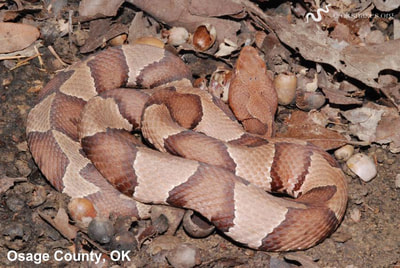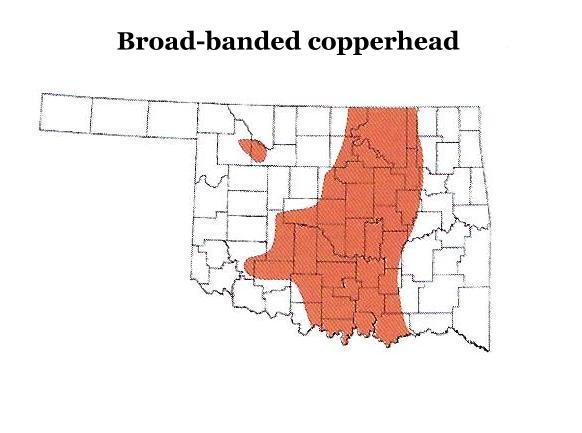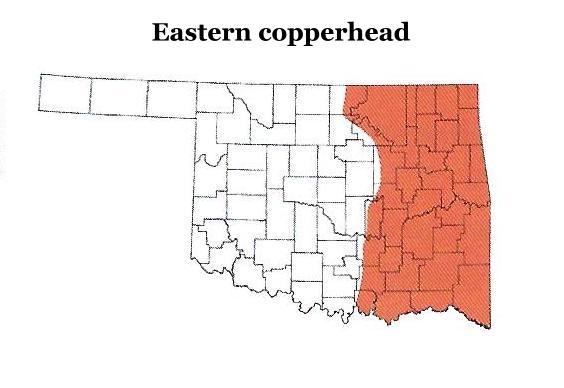Copperhead
Agkistrodon contortrix
Agkistrodon laticinctus
Agkistrodon contortrix
Agkistrodon laticinctus
VENOMOUS
Note: Oklahoma used to have 3 subspecies of copperheads but recent genetic and taxonomic work now has them listed as 2 distinct species - broad-banded (Agkistrodon laticinctus) and eastern (Agkistrodon contortrix). They look similar enough to include together on this ID page, so that's why there is only 1 copperhead entry at this time. Because we know some of you are snake nerds like us, we're including both range maps in case you want to try to definitively ID any copperhead you might find in the field.
Description:
Variable in coloration, this pit viper is generally a peachy-tan color with dark crossbands that can be brown to reddish-orange (or a copper color). This snake has weakly keeled scales, a vertical pupil (not round *), and an obvious heat-sensing pit between the eye and nostril.
* Note: Pit viper pupils can often appear round in certain lighting, such as in photos utilizing a flash. Do NOT use pupil shape as a sole means to identify any snake in Oklahoma.
Size:
Adults 22 - 36 inches (56 - 91 cm)
Prey:
Mostly small rodents, but also feeds on lizards, frogs, and some insects (mainly cicadas).
Reproduction:
Breeds in spring and gives birth to live young in late summer to early fall. Typically has 1 - 12 babies that are
8 - 10" (20 - 25 cm) long.
Habitat:
Woodlands and rocky areas near streams and ponds.
Other Information:
Newborns have a yellow tail tip that they use as a lure to catch prey, however they lose this tail coloration as adults (see photos above). These snakes bask in the mornings and retreat to shelter during the heat of the day, coming out again in the evening. Copperheads are commonly found near rock piles, logs, and other debris, using them as cover and also as a hunting ground. Their coloration allows them to blend in well with leaf litter.
Why doesn't the range map show this species in my county?
Note: Oklahoma used to have 3 subspecies of copperheads but recent genetic and taxonomic work now has them listed as 2 distinct species - broad-banded (Agkistrodon laticinctus) and eastern (Agkistrodon contortrix). They look similar enough to include together on this ID page, so that's why there is only 1 copperhead entry at this time. Because we know some of you are snake nerds like us, we're including both range maps in case you want to try to definitively ID any copperhead you might find in the field.
Description:
Variable in coloration, this pit viper is generally a peachy-tan color with dark crossbands that can be brown to reddish-orange (or a copper color). This snake has weakly keeled scales, a vertical pupil (not round *), and an obvious heat-sensing pit between the eye and nostril.
* Note: Pit viper pupils can often appear round in certain lighting, such as in photos utilizing a flash. Do NOT use pupil shape as a sole means to identify any snake in Oklahoma.
Size:
Adults 22 - 36 inches (56 - 91 cm)
Prey:
Mostly small rodents, but also feeds on lizards, frogs, and some insects (mainly cicadas).
Reproduction:
Breeds in spring and gives birth to live young in late summer to early fall. Typically has 1 - 12 babies that are
8 - 10" (20 - 25 cm) long.
Habitat:
Woodlands and rocky areas near streams and ponds.
Other Information:
Newborns have a yellow tail tip that they use as a lure to catch prey, however they lose this tail coloration as adults (see photos above). These snakes bask in the mornings and retreat to shelter during the heat of the day, coming out again in the evening. Copperheads are commonly found near rock piles, logs, and other debris, using them as cover and also as a hunting ground. Their coloration allows them to blend in well with leaf litter.
Why doesn't the range map show this species in my county?



